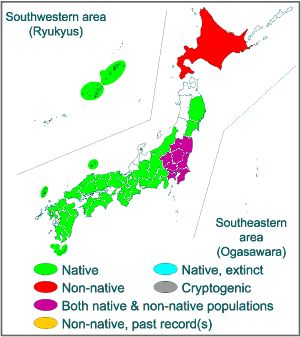
 Japanese |
English
Japanese |
English- Invasive Species of Japan >
- Fishes >
- Oryzias latipes
| Invasion information | ||
| Range in Japan | Established in Hokkaido. DNA analyses suggested that artificial introduction also occur in Tonegawa, Arakawa, and Sakawagawa River Systems in Kanto to southern Tohoku District. |

|
| Origin | According to DNA variation, Hokkaido population should be from Pacific side of Tohoku, Kanto, or Chubu District, and Kanto non-native population should be from around Seto Inland Sea, | |
| Date | This species is often released across Japan | |
| Route | Release of Medaka from different location for “conservation” and “environmental education”, and release and/or escape of pet animals | |
| Impact | Hybridization with native population in except Hokkaido. Native organism(s) affected: Native Medaka populations. | |
| Regulation in Japan | Vulnerable (VU), Red Data Book of Japan | |
| Introduced range in other countries | Russia, Turkmenistan, Kazakhstan, Iran, Afghanistan, Hawaii, Cuba, etc. (O. latipes sensu lato). | |
| Reference | Notes |
|
The populations on the entire Japan, Korean Peninsula, continental China, and Taiwan were formerly placed in Oryzias latipes sensu lato. However, the strain of Aomori Pref., Sea of Japan side of Tohoku District, Hokuriku District, around Wakasa Bay, and northern Hyogo Pref. (“Northern Japan Populations”) were described as a new species O. sakaizumii in 2011. Accordingly, the remaining populations of O. latipes sensu lato were devided as follows: the populations on the remaining part of Japan was O. latipes sensu stricto; the populations of western Korea, continental China, and Taiwan was O. sinensis; and the populations of eastern and southern Korea may be an undescribed species or subspecies of O. sakaizumii. The non-native populations within Japan may belong to O. latipes sensu stricto. Those in Turkmenistan, Iran, Afghanistan, and Kazakhstan were from China, but the origins of those in the other countries were unknown. |